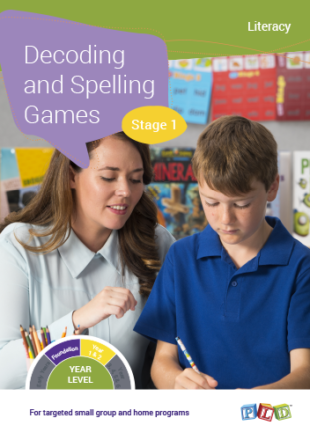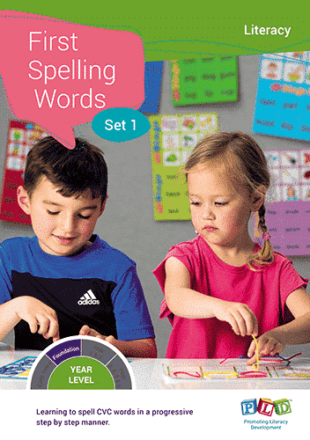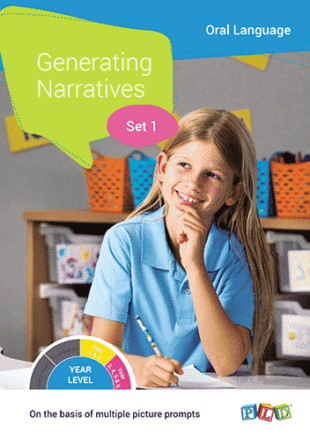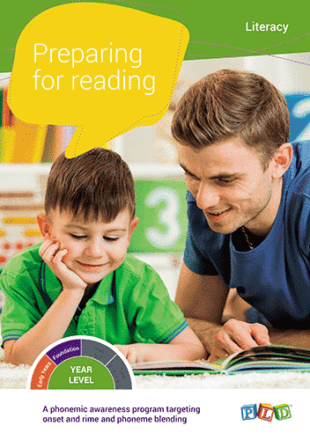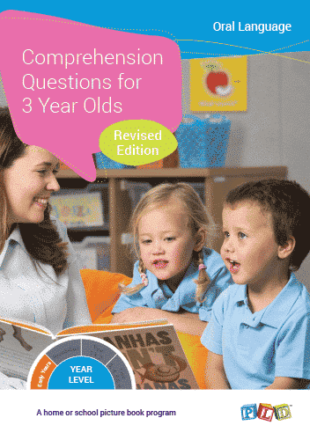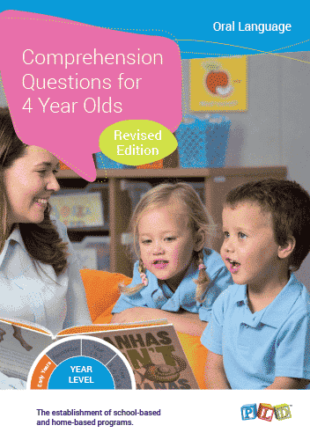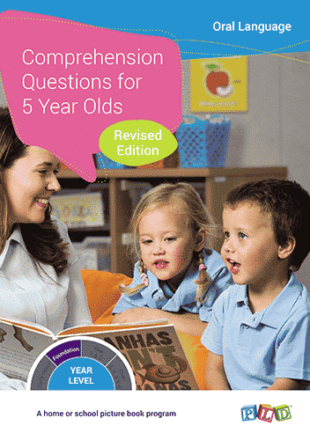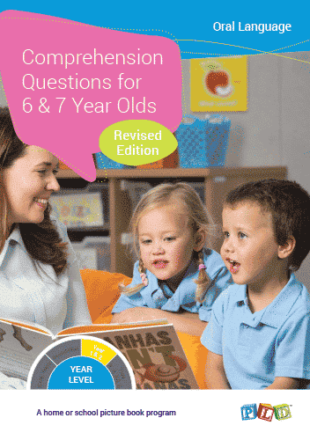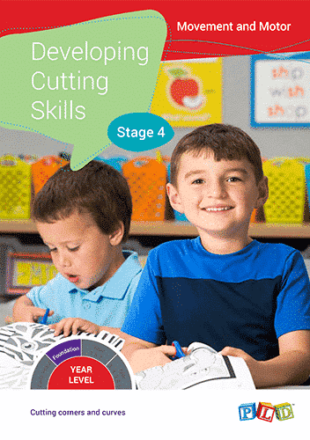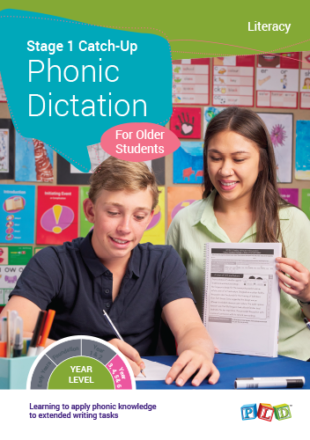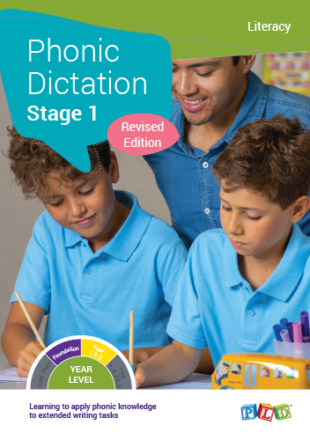School Licences
Showing 97–112 of 130 results
-
Late Stage 1 – Reading, Spelling and Writing Tasks – Target 4
Repeated practice, phonemic awareness and progress check assessments with A4 Colour Cards and Worksheets.
Introduction to the Program This program is designed to support the development of early reading and spelling skills by focusing on CVC word structures with Target 4 phonic concepts. The resources focus on incorporating phonics, phonemic awareness and multi-sensory strategies to segment and blend CVC words with Target 4 phonic concepts. The Program Includes: Sound out & Spell CVC words with 7 phonic concepts ‘ay’ & ‘ar’ ‘or’ ‘ai’ ‘ee’ ‘oy’ & ‘oi’ (short) ‘er’ (as in ‘her’ & ‘finger’) Sentence reading & writing of CVC words with 7 phonic concepts 3 Sound Phonemic Awareness Cards with 7 phonic concepts Other Programs within the Range: CVC Words Reading, Spelling and Writing Taskss Early Stage 1 – Reading, Spelling and Writing Tasks – Target 2 CCVC and CVCC Reading, Spelling and Writing Tasks – Stage 1 – Target 3 Reading, Spelling and Writing Tasks: CVC to Target 4 – Bundle Links to the Teaching Sequence Manuals Year 1 & 2 Teaching Sequence Manual
$82.50$82.50 incl. GST[flipbook-popup id=''][/flipbook-popup] -
Phonic and Sight Word Sequence
Outlining the relationship between letters and sounds.
Introduction to the Program This essential guide outlines the PLD approach to implementing reading and spelling instruction from Foundation to Year 6. The Program Includes: A structured whole-school scope and sequence, outline phonic concepts, morphology, reading and spelling words, regular and irregular high-frequency words. Termly assessments to establish the range in ability and reviewing progress. Stages 1-3 focus on teaching essential phonic concepts and common-bound morpheme suffixes. Stages 4-6 focus on extending alternative spellings of phonic concepts and more sophisticated word attack spelling based on syllables, prefixes, suffixes and morphemes. Difficulty acquiring Stage 1 concept assessments to investigate slow-to-progress students. Posters and guidelines on the explicit teaching of reading and spelling words in phonemes or syllables and irregular high-frequency words. Other Programs within the Range: CVC Words Reading, Spelling and Writing Tasks Early Stage 1 – Reading, Spelling and Writing Tasks – Target 2 CCVC and CVCC Reading, Spelling and Writing Tasks – Stage 1 – Target 3 Reading, Spelling and Writing Tasks: CVC to Target 4 – Bundle Links to the Teaching Sequence Manuals This product can be used to support the implementation of the: Foundation Teaching Sequence Manual Year 1 & 2 Teaching Sequence Manual Year 3-6 Teaching Sequence Manual
$82.50$82.50 incl. GST[flipbook-popup id=''][/flipbook-popup] -
Decoding and Spelling Games – Stage 1
A program to develop single word decoding and spelling skills for students operating at Stage 1. Games and tasks for targeted small groups and home programs.
Introduction to the Program This program is designed to reinforce the foundational skills of decoding and spelling of Stage 1 concepts. It provides structured practice in the form of simple games to help students develop accuracy and automaticity in reading and spelling early phonic concepts. The Program Includes: Stage 1- Target 1 CVC decoding and spelling games Group 1: s, p, n, i, a, t Group 2: m, r, h, e, d, c Group 3: f, l, g, o, u b Group 4: w, j, v, k, z, y, q, x Stage 1- Target 2 decoding and spelling games incorporating digraphs ‘sh’ ‘ch’ ‘th’ ‘sh’, ‘ch’, & ‘th’ combined ‘oo’ ‘ee’ ‘ck’ ‘oo’, ‘ee’ & ‘ck’ combined Stage 1- Target 3 decoding and spelling games with CCVC and CVCC words CCVC CVCC Stage 1 – Target 4 decoding and spelling games incorporating extended vowels and digraph knowledge ‘ng’ ‘ay’ ‘or’ ‘ar’ ‘ai’ ‘al(l)’ ‘wh’ & ‘qu’ Decoding and spelling activities for each phonic Target Decoding & spelling frames for word building and phoneme manipulation tasks Sound out & spell pictures with mouth cues Decoding and spelling games for each phonic Target Board games Cards for ‘Go Fish’, ‘Memory’ or ‘Snap’ games Bingo Other Programs within the Range: Decoding and Spelling Games CCVC and CVCC Reading, Spelling and Writing Tasks – Stage 1 – Target 3 Decoding and Spelling Games Bundle – Stages 1 & 2 Links to the Teaching Sequence Manuals This product can be used to support the implementation of the: Foundation Teaching Sequence Manua Year 1 & 2 Teaching Sequence Manual
$82.50$82.50 incl. GST[flipbook-popup id=''][/flipbook-popup] -
First Reading Words
A program for 4 to 6 year olds that introduces CVC reading into the early years.
Designed by a Speech Pathologist for use in schools and the home, First Reading Words presents a progressive approach to decoding (or “sounding-out”) some of the earliest reading words. Suitable for children age 4 to 6, this resource also provides ample practice reading simple regular alphabet words. Includes activities for both single word and sentence reading. Includes 10 game variations for the game boards. Includes explicit instructions on the cards and game boards. Includes: 78 x Single Word Reading Colour Cards 42 x Sentence Reading Colour Cards 2 x A3 Colour Game Boards The programs within the range include: First Spelling Words – Set 1 First Spelling Words – Set 2 First Reading Words First Writing Activities This resource is mentioned in the Foundation Teaching Sequence Manual on page 8.
$82.50$82.50 incl. GST[flipbook-popup id=''][/flipbook-popup] -
First Spelling Words – Set 1
A program for 5 to 6 year olds that introduces CVC word spelling with phonics into the early years.
Designed by Speech Pathologists for teachers and parents, First Spelling Words – Set 1 for students aged 5 to 6, includes 51 activities in three different card templates in flip book format which increase in difficulty. Explicit instruction cards with seven recommended options for use are included with the card templates. The single word spelling cards are divided into 4 progressive steps CVC words which the resource: STEP 1: 6 alphabet sounds s, a, t, p, i, n (cards with yellow borders) Example: sip, tap, pin, pan, nap, tip, tin, sit, sat, pip, nip, pat. STEP 2: 12 alphabet sounds: Step 1 plus m, r, h, e, d, c (Cards with blue borders.) Example: net, cat, hit, hen, men, man, sad, rat, ten, map, pen, mat. STEP 3: 18 alphabet sounds: Step 1 and 2 plus f, l, g, o, u, b (Cards with green borders.) Example: cot, run, pot, dog, gum, log, lip, cup, bat, leg, sun, rug. STEP 4: Basically all of the alphabet (Cards with red borders.) Example: jug, van, jog, jet, jam, vet, wet, wig, wax, fox, win, six. The programs within the range include: First Spelling Words – Set 1 First Spelling Words – Set 2 First Reading Words First Writing Activities This resource is mentioned in the Foundation Teaching Sequence Manual on page 8.
$82.50$82.50 incl. GST[flipbook-popup id=''][/flipbook-popup] -
Generating Narratives – Set 1
Building Verbal and Written Expression Through Picture Prompts
Generating Narratives: Set1 supports Year 1 to 6 students develop verbal and written storytelling skills. Using picture prompts, this resource breaks narratives into three key components: An introduction to set the scene. A complication or problem. Characters' thoughts and feelings. This program is ideal for building students' confidence in both oral and written expression, whilst fostering creativity and a deeper understanding of story structure. Program Includes: A4 book: Spiral-bound, full colour and no preparation required. 10 Storylines & Picture Cards: each with three accompanying A4 Picture Cards illustrating narrative structure (30 cards in total). Included story themes: Scarecrow Pet on the Loose Surprise Hatch Late for School Car Accident Flooded Town Escape Rabbit Campsite Danger Bolting Horse Baby Bird Falling Narrative Structure Cards: includes 10 x A4 coloured narrative structure poster cards for display. Implementation: Picture cards guide students through introductions, complications and emotions, providing repeated practise in generating ideas and composing stories. Other Programs within the Range: Generating Narratives – Set 2 Links to the Teaching Sequence Manuals: This product can be used to support the implementation of the Year 1 and 2 Teaching Sequence Manual on Page 27 This product can be used to support the implementation of the Year 3, 4, 5, and 6 Teaching Sequence Manual on Page 34
$45.00$45.00 incl. GST[flipbook-popup id=''][/flipbook-popup] -
Preparing for Reading
A phonemic awareness program for 4 and 5 year olds targeting CVC blending.
One of the most significant pre-requisites for reading, spelling and writing is phonemic awareness. Phonemic awareness is strongly associated with early literacy achievement. In Preparing for reading for 4 and 5 year olds, blending is targeted as blending represents an immediate precursor to decoding ability. This resource contains coloured card sets recommended for explicit 5 minute instruction sessions and provide clear guidelines on how to effectively teach blending. These instructions can form the basis of assistant and parent education. The PLD developmental 5 step phonological awareness process has been designed by Speech Pathologists for use in schools. When used in conjunction with PLD’s pre-literacy screening, this program forms a significant component in a school’s preventative early intervention strategy. Phonemic Awareness Readiness for Reading The phonemic awareness pre-requisite skill involved in reading simple regular CVC [consonant-vowel-consonant] words such as ‘fig’, ‘tin’ and ‘mat’ is the skill of blending. First students must learn to blend at an onset and rime level. E.g. ‘Listen carefully and put these sounds together and guess this word:’ ‘f’ (one second pause) ‘ig’?’ Students then learn to blend at the phonemic or individual sound level: E.g. ‘Listen carefully and put these sounds together and guess this word; ‘m’ (one second pause) ‘a’ (one second pause) ‘t’? Answer: ‘mat’. Features: Instruction manual (24 pages) 5 different blending activities with instructions 125+ colour cards, 3 x game boards The programs within the range include: Preparing for the Alphabet Preparing for Spelling Preparing for Reading This product is mentioned in the Early Years Teaching Sequence Manual on page 8 and the Foundation Teaching Sequence Manual on page 7 and the Year 1 & 2 Teaching Sequence Manual on page 19. Generous discounts apply for bulk orders 5 to 9 copies – 15% discount applies 10+ copies – 20% discount applies
$82.50$82.50 incl. GST[flipbook-popup id=''][/flipbook-popup] -
Comprehension Questions for 3 Year Olds
A home or school picture book program for 3 year olds.
Comprehension Questions for 3 Year Olds is a home or school resource designed to support oral language development in young children. By age 3, children should be verbal, actively engage in social interactions and understand simple, literal questions about their surroundings. This program, developed by speech pathologists, supports the development of these foundational comprehension skills using engaging picture books to ask age-appropriate questions and assess oral responses. Oral language skills are critical for social interaction and academic success. Program Includes: Picture Book Recommendations: List of developmentally appropriate Picture Book recommendations, such as 'Spot Can Count', 'The Very Hungry Caterpillar' and 'We're Going on a Bear Hunt'. 35 Question Cards for Repeated Reading Sessions: Develop blending skills through engaging visuals. Each card contains sample questions (over four days) and model answers based on each recommended picture book. Questions focus on Blank Level 1 and 2 skills, such as 'What is it?' or 'What colour is it?' Instruction Booklet: Guidance for presenting in group, class or home settings. Strategies for Success: Techniques for responding to inadequate answers. Progress Check: Two assessments to monitor comprehension skill development. Other Programs within the Range: Comprehension Questions for 3 Year Old (Mc3) Parent Training Video: 3 Year Olds Comprehension Questions for 4 Year Old (Mc4) Parent Training Video: 4 Year Olds Comprehension Questions for 5 Year Old (Mc5) Parent Training Video: 5 Year Olds Comprehension Questions for 6 and 7 Year Old (Mc6) Parent Training Video: 6 and 7 Year Olds Comprehension Questions for 8 and 9 Year Old (Mc8) Parent Training Video: 8 and 9 Year Olds The full set of Comprehension Questions Range (Mc3/4/5/6/8) Links to the Teaching Sequence Manuals: This product can be used to support the implementation of the Early Years Teaching Sequence Manual on Page 5
$82.50$82.50 incl. GST[flipbook-popup id=''][/flipbook-popup] -
Comprehension Questions for 4 Year Olds
A home or school picture book program for 4 Year Old students.
Comprehension Questions for 4 Year Olds is a home or school resource designed to support oral language development in young children. From a young age, children should be verbal, actively engage in social interactions and understand simple, literal questions about their surroundings. By age 4, children begin answering more complex questions, requiring them to identify less obvious attributes, make predictions and sequence information. This program, developed by speech pathologists, supports the development of these foundational comprehension skills using engaging picture books to ask age-appropriate questions and assess oral responses. Oral language skills are critical for social interaction and academic success. Program Includes: Picture Book Recommendations: List of developmentally appropriate Picture Book recommendations, such as 'Piranhas Don't Eat Bananas' and 'We're Going on a Bear Hunt'. 41 Question Cards for Repeated Reading Sessions: Develop blending skills through engaging visuals. Each card contains sample questions (over four days) and model answers based on each recommended picture book. Questions focus on Blank Level 2 and 3 skills, such as 'What is this part used for?' or 'How did you feel?' Instruction Booklet: Guidance for presenting in group, class or home settings. Strategies for Success: Techniques for responding to inadequate answers. Progress Check: Two assessments to monitor comprehension skill development. Other Programs within the Range: Comprehension Questions for 3 Year Old (Mc3) Parent Training Video: 3 Year Olds Comprehension Questions for 4 Year Old (Mc4) Parent Training Video: 4 Year Olds Comprehension Questions for 5 Year Old (Mc5) Parent Training Video: 5 Year Olds Comprehension Questions for 6 and 7 Year Old (Mc6) Parent Training Video: 6 and 7 Year Olds Comprehension Questions for 8 and 9 Year Old (Mc8) Parent Training Video: 8 and 9 Year Olds The full set of Comprehension Questions Range (Mc3/4/5/6/8) Links to the Teaching Sequence Manuals: This product can be used to support the implementation of the Early Years Teaching Sequence Manual on Page 5
$82.50$82.50 incl. GST[flipbook-popup id=''][/flipbook-popup] -
Comprehension Questions for 5 Year Olds
Picture Book Program for 5 Year Olds: Perfect for Home or School
Comprehension Questions for 5 Year Olds is a home or school resource designed to support oral language development in young children. From a young age, children should be verbal, actively engage in social interactions and understand simple, literal questions about their surroundings. By age 5, children begin answering more complex questions that involve predicting, explaining outcomes and considering alternative possibilities. This program, developed by speech pathologists, supports the development of these foundational comprehension skills using engaging picture books to ask age-appropriate questions and assess oral responses. Oral language skills are critical for social interaction and academic success. Program Includes: Picture Book Recommendations: List of developmentally appropriate Picture Book recommendations, such as 'A Lion in the Night', 'The Gruffalo' and 'The Very Hungry Caterpillar'. 42 Question Cards for Repeated Reading Sessions: Each card contains sample questions (over four days) and model answers based on each recommended picture book. Questions focus on Blank Level 3 and 4 skills, such as 'Why did that happen?', 'What would you use?' or 'Why can't we?' Instruction Booklet: Guidance for presenting in group, class or home settings. Strategies for Success: Techniques for responding to inadequate answers. Progress Check: Two assessments to monitor comprehension skill development. Other Programs within the Range: Comprehension Questions for 3 Year Old (Mc3) Parent Training Video: 3 Year Olds Comprehension Questions for 4 Year Old (Mc4) Parent Training Video: 4 Year Olds Comprehension Questions for 5 Year Old (Mc5) Parent Training Video: 5 Year Olds Comprehension Questions for 6 and 7 Year Old (Mc6) Parent Training Video: 6 and 7 Year Olds Comprehension Questions for 8 and 9 Year Old (Mc8) Parent Training Video: 8 and 9 Year Olds The full set of Comprehension Questions Range (Mc3/4/5/6/8) Links to the Teaching Sequence Manuals: This product can be used to support the implementation of the Foundation Teaching Sequence Manual on Page 14
$82.50$82.50 incl. GST[flipbook-popup id=''][/flipbook-popup] -
Comprehension Questions for 6 and 7 Year Olds
Picture Book Program for 6 & 7 Year Olds: Perfect for Home or School
Comprehension Questions for 6 and 7 Year Olds is a home or school resource designed to support oral language development in young children. From a young age, children should be verbal, actively engage in social interactions and understand simple, literal questions about their surroundings. By age 6 and 7, children begin answering more complex questions requiring prediction, interpretation and evaluation. This program, developed by speech pathologists, supports the development of these foundational comprehension skills using engaging picture books to ask age-appropriate questions and assess oral responses. Oral language skills are critical for social interaction and academic success. Program Includes: Picture Book Recommendations: List of developmentally appropriate Picture Book recommendations, such as 'Arthur', 'The Rainbow Fish' and 'Possum Magic'. 40 Question Cards for Repeated Reading Sessions: Develop blending skills through engaging visuals. Each card contains sample questions (over four days) and model answers based on each recommended picture book. Questions are focused on encouraging students to predict, to interpret and to evaluate, such as 'What would happen if…?', 'How can we tell…?' or 'Which part of the story…?' Instruction Booklet: Guidance for presenting in group, class or home settings. Strategies for Success: Techniques for responding to inadequate answers. Progress Check: Two assessments to monitor comprehension skill development. Other Programs within the Range: Comprehension Questions for 3 Year Old (Mc3) Parent Training Video: 3 Year Olds Comprehension Questions for 4 Year Old (Mc4) Parent Training Video: 4 Year Olds Comprehension Questions for 5 Year Old (Mc5) Parent Training Video: 5 Year Olds Comprehension Questions for 6 and 7 Year Old (Mc6) Parent Training Video: 6 and 7 Year Olds Comprehension Questions for 8 and 9 Year Old (Mc8) Parent Training Video: 8 and 9 Year Olds The full set of Comprehension Questions Range (Mc3/4/5/6/8) Links to the Teaching Sequence Manuals: This product can be used to support the implementation of the Year 1 and 2 Teaching Sequence Manual on Page 27
$82.50$82.50 incl. GST[flipbook-popup id=''][/flipbook-popup] -
Comprehension Questions for 8 and 9 Year Olds
Picture Book Program for 8 & 9 Year Olds: Perfect for Home or School
Comprehension Questions for 8 & 9 Year Olds is a home or school resource designed to support oral language development in young children. From a young age, children should be verbal, actively engage in social interactions and understand simple, literal questions about their surroundings. By age 8 and 9, children further develop their focus on answering complex questions requiring prediction, interpretation and evaluation. This program, developed by speech pathologists, supports the development of these foundational comprehension skills using engaging picture books to ask age-appropriate questions and assess oral responses. Oral language skills are critical for social interaction and academic success. Program Includes: Picture Book Recommendations: List of developmentally appropriate Picture Book recommendations, such as 'The Gruffalo', 'The Giving Tree' and 'Diary of a Womat'. 33 Question Cards for Repeated Reading Sessions: Each card contains sample questions (over four days) and model answers based on each recommended picture book. Questions are focused on encouraging students to predict, to interpret and to evaluate, such as 'Why do you think…?' 'How do you think the girl would feel?' or 'Why do you like that one best?' Instruction Booklet: Guidance for presenting in group, class or home settings. Strategies for Success: Techniques for responding to inadequate answers. Progress Check: Two assessments to monitor comprehension skill development. Other Programs within the Range: Comprehension Questions for 3 Year Old (Mc3) Parent Training Video: 3 Year Olds Comprehension Questions for 4 Year Old (Mc4) Parent Training Video: 4 Year Olds Comprehension Questions for 5 Year Old (Mc5) Parent Training Video: 5 Year Olds Comprehension Questions for 6 and 7 Year Old (Mc6) Parent Training Video: 6 and 7 Year Olds Comprehension Questions for 8 and 9 Year Old (Mc8) Parent Training Video: 8 and 9 Year Olds The full set of Comprehension Questions Range (Mc3/4/5/6/8) Links to the Teaching Sequence Manuals: This product can be used to support the implementation of the Year 3, 4, 5 & 6 Teaching Sequence Manual on Page 30
$82.50$82.50 incl. GST[flipbook-popup id=''][/flipbook-popup] -
Developing Cutting Skills – Stage 4
Cutting tasks with corners and curves.
Developing Cutting Skills – Stage 4 is one of a series of two books created by occupational therapists and teachers to support the development of cutting skills in children between the ages of 3 and 6 at school or home. The activities target specific skills that will enable children to develop the coordination and motor skills required for cutting. Multiple opportunities to rehearse cutting skills are provided through simple, easy-to-use worksheets with clear instructions. The series outlines developmental milestones that can be useful for planning, assessment and creating individual education plans. Developing cutting skills is part of a holistic approach to promoting a comprehensive foundation for academic success. From holding scissors to snipping and cutting along a line, this book features: Simple and easy to use, the resource targets scissor skills in early childhood and developmental manner Provides multiple opportunities to rehearse cutting skills Developmental milestone norms throughout the manual This product is mentioned in the Foundation Teaching Sequence Manual on page 14. There are two resources in this series: Developing Cutting Skills – Step 1, 2 & 3 Developing Cutting Skills – Stage 4
$82.50$82.50 incl. GST[flipbook-popup id=''][/flipbook-popup] -
Stage 1 Catch Up Phonic Dictation (For Older Students)
Learning to apply phonic knowledge to extended writing tasks
Phonic Dictation: Stage 1 Catch-Up for older students supports students to bridge the gap between correctly spelling test words and applying their skills to extended writing. By completing regular dictation tasks, students rehearse and reinforce their phonics and spelling knowledge in increasingly complex contexts, improving their ability to transfer skills to self-generated writing. Dictation sessions are quick to prepare yet deliver significant benefits across key literacy areas, including: Listening and auditory memory Handwriting and language development Spelling application Program Includes: A4, spiral-bound book. Age-appropriate passages for older students operating at a Junior Primary level. Three levels of phonic passages: full-length passage format, ideal for Tier 1 students, and two shortened versions with reduced word counts for students requiring modifications. Alphabet VC and CVC words. Phonic concepts: /sh/ /ch/ /th/ /oo/ /ee/ /ck/ to CVC words. Consonant blends: CCVC and CVCC words. Phonic concepts: /ar/ /or/ /ay/ /ai/ /oy/ /oi/ /er/ /ing/ Additional passages covering concepts such as, prefixes, suffixes, high frequency words and homophones have been included in the APPENDIX section of the program. Other Programs within the Range: First Writing Activities (Foundation) Phonic Diction: Stage 1 Phonic Diction: Stage 2 Phonic Diction: Stage 3 Phonic Diction: Stage 4 Phonic Diction: Stage 5 Phonic Diction: Stage 6 Phonic Diction: Junior & Middle Primary Set (Stage 1, 2, 3, 4) Full Set of Phonic Diction Books (Discounted Bundle) Phonic Diction: Stage 1 Catch-Up (For Older Students) Phonic Diction: Stage 2 Catch-Up (For Older Students) Bulk Order Discounts 5-9 copies: 10% off 10+ copies: 15% off Links to the Teaching Sequence Manuals: This product can be used to support the implementation of the Year 1 and 2 Teaching Sequence Manual
$82.50$82.50 incl. GST[flipbook-popup id=''][/flipbook-popup] -
Phonic Dictation – Stage 1
Applying Phonic Knowledge to Extended Writing Tasks
Phonic Dictation: Stage 1 supports students to bridge the gap between correctly spelling test words and applying their skills to extended writing. By completing regular dictation tasks, students rehearse and reinforce their phonics and spelling knowledge in increasingly complex contexts, improving their ability to transfer skills to self-generated writing. Dictation sessions are quick to prepare yet deliver significant benefits across key literacy areas, including: Listening and auditory memory Handwriting and language development Spelling application Program Includes: A4, spiral-bound book. Three levels of phonic passages: full-length passage format, ideal for Tier 1 students, and two shortened versions with reduced word counts for students requiring modifications. Alphabet VC and CVC words. Phonic concepts: /sh/ /ch/ /th/ /oo/ /ee/ /ck/ to CVC words. Consonant blends: CCVC and CVCC words. Phonic concepts: /ar/ /or/ /ay/ /ai/ /oy/ /oi/ /er/ /ing/ Additional passages covering concepts such as, prefixes, suffixes, high frequency words and homophones have been included in the APPENDIX section of the program. Other Programs within the Range: First Writing Activities (Foundation) Phonic Diction: Stage 1 Phonic Diction: Stage 2 Phonic Diction: Stage 3 Phonic Diction: Stage 4 Phonic Diction: Stage 5 Phonic Diction: Stage 6 Phonic Diction: Junior & Middle Primary Set (Stage 1, 2, 3, 4) Full Set of Phonic Diction Books (Discounted Bundle) Phonic Diction: Stage 1 Catch-Up (For Older Students) Phonic Diction: Stage 2 Catch-Up (For Older Students) Bulk Order Discounts 5-9 copies: 10% off 10+ copies: 15% off Links to the Teaching Sequence Manuals: This product can be used to support the implementation of the Year 1 and 2 Teaching Sequence Manual
$82.50$82.50 incl. GST[flipbook-popup id=''][/flipbook-popup] -
Stage 2 Catch Up Phonic Dictation (For Older Students)
Learning to apply phonic knowledge to extended writing tasks.
Phonic Dictation: Stage 2 Catch-Up for Older Students supports students to bridge the gap between correctly spelling test words and applying their skills to extended writing. By completing regular dictation tasks, students rehearse and reinforce their phonics and spelling knowledge in increasingly complex contexts, improving their ability to transfer skills to self-generated writing. Dictation sessions are quick to prepare yet deliver significant benefits across key literacy areas, including: Listening and auditory memory Handwriting and language development Spelling application Program Includes: A4, spiral-bound book. Age-appropriate passages for older students operating at a Junior Primary level. Three levels of phonic passages: full-length passage format, ideal for Tier 1 students, and two shortened versions with reduced word counts for students requiring modifications. Phonic concepts: /sh/ /ch/ /th/ /oo/ /ee/ /ck/ /ar/ /or/ /ay/ /ai/ /oy/ /oi/ /er/ /ing/. Consonant clusters and double consonants. Long vowels: /a-e/ /e-e/ /i-e/ /o-e/ /u-e/ Phonic concepts: /oa/ and /ow/ (as oa), /ir/ (as er), /ur/ (as er), /er/ and /aw/ (as or) /or/, /ea/ (as ee) /ee/, /ou/ and /ow/ (as ou) etc. Additional passages covering concepts such as, prefixes, suffixes, high frequency words and homophones have been included in the APPENDIX section of the program. Other Programs within the Range: First Writing Activities (Foundation) Phonic Diction: Stage 1 Phonic Diction: Stage 2 Phonic Diction: Stage 3 Phonic Diction: Stage 4 Phonic Diction: Stage 5 Phonic Diction: Stage 6 Phonic Diction: Junior & Middle Primary Set (Stage 1, 2, 3, 4) Full Set of Phonic Diction Books (Discounted Bundle) Phonic Diction: Stage 1 Catch-Up (For Older Students) Phonic Diction: Stage 2 Catch-Up (For Older Students) Bulk Order Discounts 5-9 copies: 10% off 10+ copies: 15% off Links to the Teaching Sequence Manuals: This product can be used to support the implementation of the Year 3, 4, 5 and 6 Teaching Sequence Manual
$82.50$82.50 incl. GST[flipbook-popup id=''][/flipbook-popup]





